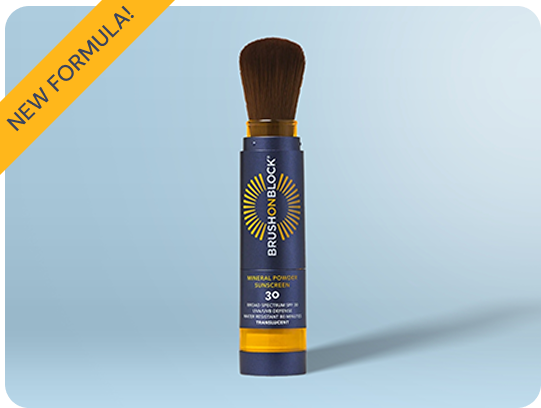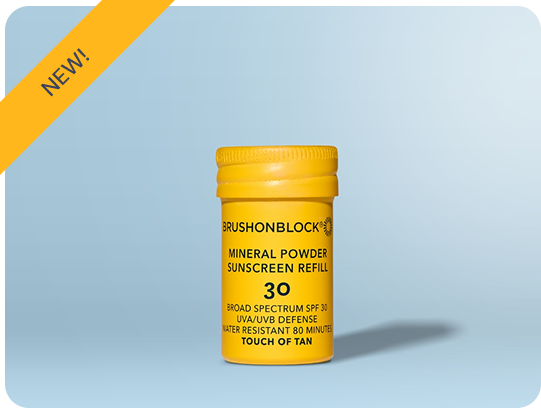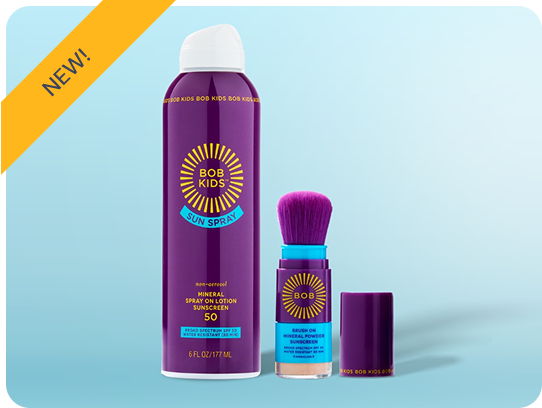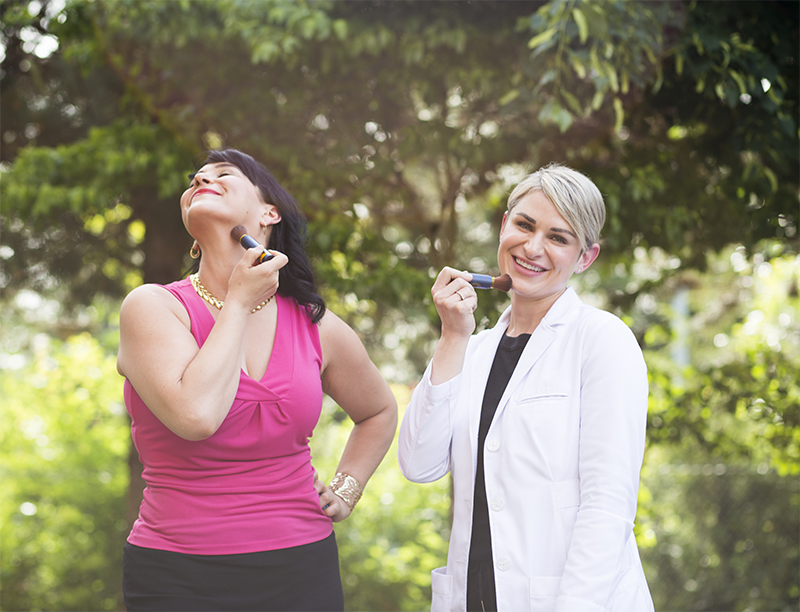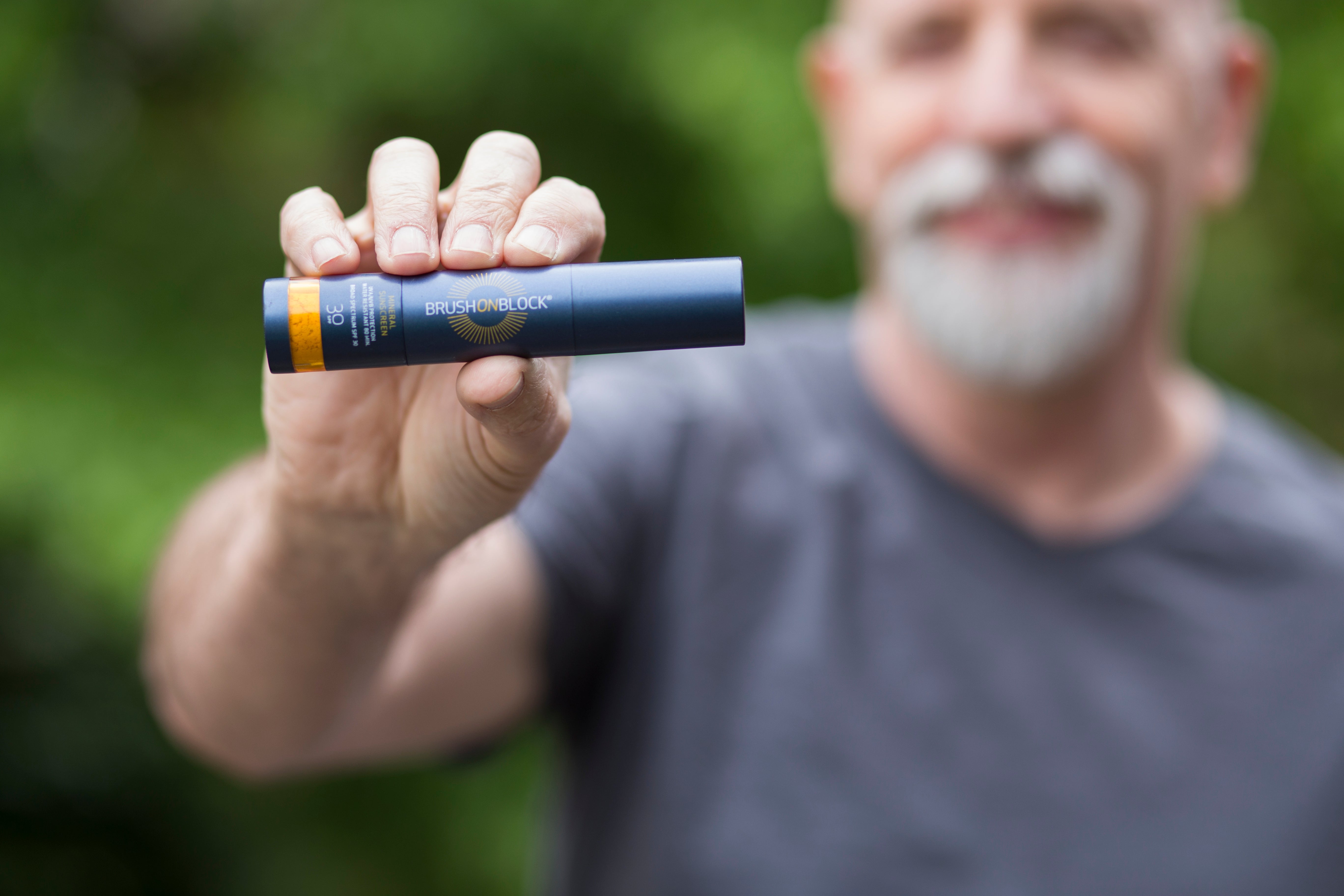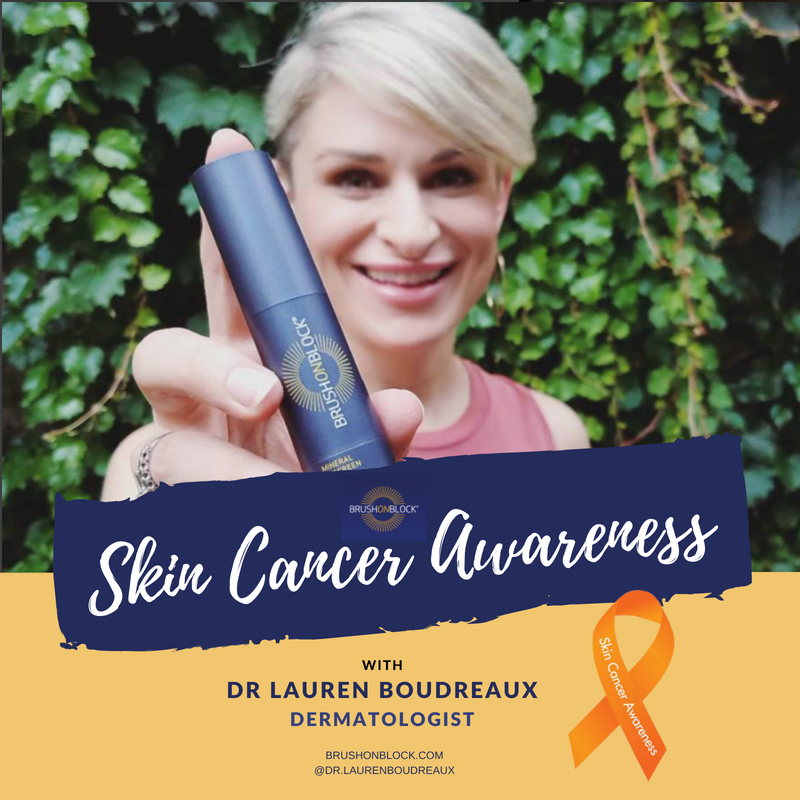For Skin Cancer Awareness Month, Brush On Block hosted a Facebook Live and answered your burning (pun intended) sun care questions! Our expert guest, Portland-based dermatologist Dr. Lauren Boudreaux of Silver Falls Dermatology, offered some excellent advice and graciously shared her knowledge. Augustina Elizabeth, a local actress and lifestyle blogger, acted as an excellent host. Watch the recorded session (at the bottom of this post) or read some highlights below to get a little more Sun-Smart!
Augustina: Why is it so important to wear sunscreen?
Dr. Lauren Boudreaux: UV radiation is a known carcinogen and we know it leads to skin cancer. The more cumulative UV exposure you have, the more likely you are to get skin cancer. So first and foremost, is skin cancer prevention. Secondly, it will help prevent aging. Regular use of sunscreen has been shown to help you look younger and even reverse some of the signs of skin aging.
A: Explain reversing.
DLB: More permanent things that are difficult to reverse with just sunscreen alone would be wrinkles, pebbly appearance to the skin. We can reverse that with things like lasers, chemical peels, fillers, stuff like that. But the things that can be reversed with sunscreen would be sun spots, any brown spots, even pre cancers have been shown to lessen if we have regular use of sunscreen because it allows your body to start to amount this immune response and fight off some of that damage. It's never too late!

A: What are some of the signs of precancer?
DLB: So precancers are precursors to squamous cell carcinoma which is a common skin cancer type. They look like red, rough scaly patches that you almost feel more than see. They're pretty subtle. Oftentimes patients will come in and say, "Hey, I have this rough spot on my face. What do you think of it?" That's often a sign of a precancer.
Now onto the progression to skin cancer. The most common skin cancer is basal cell carcinoma. That is actually the most common cancer overall in the US. It's higher than all other skin cancers combined in the US. So skin cancer is very prevalent. Basal cell looks like a pimple that won't go away; kind of a pearly pink bump. Squamous cell is again, the red rough scaly patch that might bleed, something like that. Anything within that category would be signs of non-melanoma skin cancer.
Melanoma is the pigmented skin cancer and that's really the scary one that we want to watch out for. That looks like a changing mole, irregular borders, asymmetry, two more colors, typically a larger lesion about the size of a pencil eraser or bigger. Any changes you see in that should be checked out.
A: How soon should you get checked out if you see these signs?
DLB: As soon as possible!
A: So basically, once you see a mole change, you should head straight into the dermatologist.
DLB: Yes!

A: We have a question from Nancy. She says "I am in my 60s, I never wore sunscreen. What can do now to keep from getting melanoma or skin cancer?"
DLB: So we can't undo what we did in the past, but at your age, Nancy, we generally recommend yearly skin exams preventatively to screen for these kinds of changes. Sunscreen use everyday, again, has been shown to help prevent further development of the DNA mutations that can lead to cancer. It doesn't have to just be sunscreen. There's sun protective clothing, there's hats! In Oregon we're pretty active, we go out and do stuff - I'm not saying be a hermit and don't go outside - but use things like Brush On Block, to help maintain your daily protection and sun protective clothing if you're out a lot.
A: We have a question from Sarah in Colorado. She says, "I have sunscreen in my makeup. I also wear sunscreen over my makeup. Does that mean that I am double-covered?"
DLB: I get this question almost everyday! Generally for women, the SPF that is advertised in makeup is not truly what you're getting. Because you need to use a decent amount of product to be able to cover your face and if you put that much makeup on, it would look very caky, tacky. So most people aren't wearing that much foundation. The SPF on top that you're using is good - usually people put [sunscreen] on the bottom [underneath makeup] and then use something like Brush On Block on top, and that will give you added protection. So generally, makeup with sunscreen in it is a little bit extra but not as much as they advertise. So, don't rely on it!
A: So if my makeup says SPF 17, and then I'm putting on Brush On Block which is SPF 30, that doesn't mean I'm getting SPF 47.
DLB: Right! It's not additive like that. That kind of brings up another interesting topic which is what is SPF and what SPF do we need to use? Generally, in places in the Northern US an SPF 15 or higher is good for everyday use unless you're going to be out. Same with darker skin types. I tell most of my Caucasian patients to use SPF 30 or higher everyday. The protection you're getting is sort of on a logarithmic curve. You can imagine SPF 5 being down low on the curve, SPF 15 being a little bit higher, and then eventually you reach SPF 30, SPF 50 and you're blocking out about 98 to 99 percent of those UV rays. Once we get past SPF 50, it's like 98.1, 98.2, 98.3... So we're not getting that much added protection above SPF 30, SPF 50. So the SPF 30 that is in Brush On Block is really good protection. That's generally what you need unless you are out for a really long period of time or closer to the equator.
A: What should you do if you get itching when applying sunscreen?
DLB: Allergies to sunscreen are not terribly uncommon. It's more likely to happen with the chemical blockers like oxybenzone, avobenzone. The great thing about products that are physical blockers like Brush On Block, is that they are way less likely to irritate skin. If you're still having itching with a physical blocker, you may want to get tested for other allergens that could be in sunscreens. But this is about as chemically inert as we get with sunscreen, so it's very safe and way less likely to cause a reaction - we almost never hear of it with products like Brush On Block with zinc oxide and titanium dioxide.
A: Can you name some of the biggest myths of sun protection?
DLB: Yes! A common mistake, not necessarily a myth, is not putting on enough sunscreen. You need a one-ounce shot glass of product to cover your whole body. Most people aren't putting on enough. So just be mindful of that. For the face, you need 3 to 5 grams of product, which is about the size of your finger tip. You need more to cover your chest - which is another thing that people always forget to do and we see a ton of sun damage on the chest. Be mindful to carry your product down. You probably want to use 3-4 pumps of a product or about a finger amount for that area. That's even more than I put on, so I get it! It may be hard, but just be mindful of that. Layering things like Brush On Block can be helpful to give you a little more added protection if you're not putting on quite as much as I'm suggesting.

A: What ingredients should we be looking for in an eco-friendly sunscreen?
DLB: You'll want to make sure it does not have the oxybenzone in it. That is the only chemical ingredient that is linked to that. There are several brands that boast being vegan and cruelty-free, as well as environmentally safe. Brush On Block is one of them, which is part of why I love that product. Coola is another one. If you search for those terms online, you will find brands that specifically eliminate those harmful ingredients, and fall under eco-friendly.
A: A viewer, Sofia says, "My boyfriend hates applying sunscreen and how it feels. Do you have clients who feel this way too? How can applying sunscreen be less of a chore and what might I be able to say to convince him that he should wear it?"
DLB: I ran into the same thing with my husband! Guys in general just don't want to put anything on their face. It's a matter of finding one that he will actually wear. I think Brush On Block is a perfect example of that because it's not sticky, it's not tacky, it doesn't feel like much of anything on the face and it's easy to apply it really quickly. Other than that, over-the-counter, I really like Eucerin Daily Uv Protection. It's SPF 30, it's nice and thin and transparent. Neutrogena has a Healthy Defense Moisturizer with sunscreen. And if Sofia wants to scare her boyfriend into it, there's a lot of scary facts on the AAD's website! So if you go on aad.org, you can look up some skin cancer facts and they've got a lot of interesting facts about the sun. That's what I had to do!
A: Do you have any recommendations of sunscreen for dark skin?
DLB: So people with dark skin, still need sunscreen! We still see skin cancer in darker skin types. Then more importantly, and most of what my patients complain about, is that the darker your skin type is the more likely you are to pigment from sun exposure. People don't like getting brown spots, or pimples that leave post-inflammatory pigmentation which will be only be worse the more sun exposure you're getting. Regular sunscreen application is important for that skin type too.
Now, what type of sunscreen? That is the million-dollar question. The physical blockers, zinc and titanium are going to be difficult to use. They usually look very white and ashy on any pigmented skin, it typically doesn't do so well. So shifting toward the chemical blockers in your case, will probably be the way to go. SuperGoop has one called "unseen sunscreen" that is clear and it is like a silicone primer -it feels glorious! I would definitely recommend that one to anyone with more pigment to their skin that can't tolerate the physical blockers.
A: Kim asks, "My friend loves tanning, both indoor and outdoor. And has developed an abnormal freckle on her lip. What do you recommend I tell her about tanning to get her to stop? Is there such a thing as a safe tan?"
DLB: There's no such thing as a safe tan. Even my patients will try to justify that with me as they're getting a base tan because they're going on vacation! The base tan does not provide you any extra protection. People think that because you're not sun burning that you're not getting any damage. Doing these indoor tanning sessions for base tans before vacation lead to higher rates of skin cancer development than when you don't do that. If you have 5 or more sunburns you will have a 75% increase in your risk of melanoma. If you've done 5 or more indoor tanning sessions, it doubles your risk of melanoma. It's really, really dangerous - don't do it! The more I learn about tanning, the more scared I am of it.
Laying out in the sun is not safer. They both are equally bad. Don't let the tanning salons tell you that we're they're doing is safe - it's just not. Some people will go to tanning salons because they have a skin condition that can respond to UV therapy. But the light boxes we use here in clinic filter out the UVA. UVA is what's damaging your skin. UVA is in the tanning beds and it's outside. You want to get UV therapy done at a clinic if you're doing it for that sort of thing.
Learn more from our Facebook live session by watching the video below!
